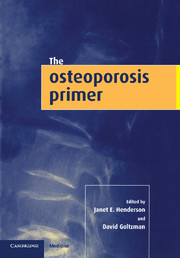Book contents
- Frontmatter
- Contents
- List of contributors
- Preface
- Part 1 Molecular and cellular environment of bone
- Part II Determinants of peak bone mass
- 10 Genetic determinants of osteoporosis
- 11 Non-genetic determinants of peak bone mass
- 12 Bone mineral acquisition during childhood and adolescence: physical exercise as a preventative measure
- 13 Osteoporosis in children
- Part III Pathophysiology of the aging skeleton
- Part IV Clinical aspects of osteoporosis
- Index
12 - Bone mineral acquisition during childhood and adolescence: physical exercise as a preventative measure
Published online by Cambridge University Press: 01 June 2011
- Frontmatter
- Contents
- List of contributors
- Preface
- Part 1 Molecular and cellular environment of bone
- Part II Determinants of peak bone mass
- 10 Genetic determinants of osteoporosis
- 11 Non-genetic determinants of peak bone mass
- 12 Bone mineral acquisition during childhood and adolescence: physical exercise as a preventative measure
- 13 Osteoporosis in children
- Part III Pathophysiology of the aging skeleton
- Part IV Clinical aspects of osteoporosis
- Index
Summary
Introduction
The history of the human species has always included a lifestyle demanding heavy and prolonged physical work that was necessary for survival (Bortz, 1985). It has been estimated that the skeletal mass of humans living in the Late Paleolithic era exceeded that of humans in subsequent civilizations (Larsen, 1987; Wolpoff, 1980). This is attributed, in part, to the heavy physical exertion required for subsistence at that time (Eaton et al., 1988). Times, however, have changed and conditions of disuse have become firmly entrenched in our medical vocabulary.
It has been suggested that the ability of bone to adapt to mechanical loading is much greater in the immature, as compared to the mature, skeleton (Parfitt, 1994). Osteoporosis prevention, therefore, may begin early in life when optimal bone mineral accretion is critical to the attainment of a healthy adult skeleton (Bailey & McCulloch, 1992; Fassler & Bonjour, 1996; Parfitt, 1994). Peak bone mass is a major determinant of adult bone mass which is, in turn, related to fracture risk (Matkovic et al., 1979). Upwards of 90% of adult bone mass is achieved by the end of adolescence and subsequent gains are relatively small (Bonjour et al., 1991; Glastre et al., 1990; Slemenda et al., 1994; Theintz et al., 1992).
- Type
- Chapter
- Information
- The Osteoporosis Primer , pp. 170 - 185Publisher: Cambridge University PressPrint publication year: 2000



